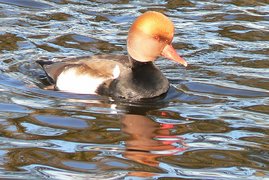%2520Helen%2520Babbs.jpg)
It may not be a seaside town, but London’s connections with the sea are strong. The moods of the tidal Thames are a powerful, daily reminder of how close we are to the ocean, and the river is home to some fascinating wildlife. An hour’s beach combing at low tide reveals the presence of fish, crabs, leeches, mussels, shrimps and snails living in the pools, rich mud, sand and gravels that the retreating water leaves behind.
Focus on species: the European eel Anguilla anguilla
Journeying from the Sargasso Sea to the Thames
 The European eel starts life in the Sargasso Sea, in the Northern Atlantic Ocean. The leaf shaped larvae, known as leptocephalii, ride on the currents of the Gulf Stream and North Atlantic Drift towards Europe and North Africa. When they reach European shores, they metamorphose into the transparent glass eels that resemble the eel shape we know. As they move further inshore, and ride the tides up estuaries and tidal rivers, the freshwater mix triggers pigmentation and at this stage they are called elvers. They spend many years in this environment, either hugging the coastline of estuaries or moving into freshwater, where they turn a yellow colour, gain body weight and grow in length. The European eel tends to feed at night, and is partial to fish and invertebrates. During winter months they may become inactive if the temperatures are low. Growth is determined by several factors, including availability of food, average ambient temperature and stock density. The eel is predated upon by birds, and is a favourite food of bittern and cormorants, as well as the otter.
The European eel starts life in the Sargasso Sea, in the Northern Atlantic Ocean. The leaf shaped larvae, known as leptocephalii, ride on the currents of the Gulf Stream and North Atlantic Drift towards Europe and North Africa. When they reach European shores, they metamorphose into the transparent glass eels that resemble the eel shape we know. As they move further inshore, and ride the tides up estuaries and tidal rivers, the freshwater mix triggers pigmentation and at this stage they are called elvers. They spend many years in this environment, either hugging the coastline of estuaries or moving into freshwater, where they turn a yellow colour, gain body weight and grow in length. The European eel tends to feed at night, and is partial to fish and invertebrates. During winter months they may become inactive if the temperatures are low. Growth is determined by several factors, including availability of food, average ambient temperature and stock density. The eel is predated upon by birds, and is a favourite food of bittern and cormorants, as well as the otter.
Focus on species: the European eel Anguilla anguilla
Any true Cockney will be familiar with the jellied eel, once common fare, now perhaps more of an East End delicacy, or even a culinary dare. The European eel is actually one of the Thames’ most interesting species. Long lived, multi-coloured and with females growing up to a metre in length, this Londoner originates from the mysterious, saltier climes of the Sargasso Sea, migrating back there when it’s ready to breed.
Journeying from the Sargasso Sea to the Thames
 The European eel starts life in the Sargasso Sea, in the Northern Atlantic Ocean. The leaf shaped larvae, known as leptocephalii, ride on the currents of the Gulf Stream and North Atlantic Drift towards Europe and North Africa. When they reach European shores, they metamorphose into the transparent glass eels that resemble the eel shape we know. As they move further inshore, and ride the tides up estuaries and tidal rivers, the freshwater mix triggers pigmentation and at this stage they are called elvers. They spend many years in this environment, either hugging the coastline of estuaries or moving into freshwater, where they turn a yellow colour, gain body weight and grow in length. The European eel tends to feed at night, and is partial to fish and invertebrates. During winter months they may become inactive if the temperatures are low. Growth is determined by several factors, including availability of food, average ambient temperature and stock density. The eel is predated upon by birds, and is a favourite food of bittern and cormorants, as well as the otter.
The European eel starts life in the Sargasso Sea, in the Northern Atlantic Ocean. The leaf shaped larvae, known as leptocephalii, ride on the currents of the Gulf Stream and North Atlantic Drift towards Europe and North Africa. When they reach European shores, they metamorphose into the transparent glass eels that resemble the eel shape we know. As they move further inshore, and ride the tides up estuaries and tidal rivers, the freshwater mix triggers pigmentation and at this stage they are called elvers. They spend many years in this environment, either hugging the coastline of estuaries or moving into freshwater, where they turn a yellow colour, gain body weight and grow in length. The European eel tends to feed at night, and is partial to fish and invertebrates. During winter months they may become inactive if the temperatures are low. Growth is determined by several factors, including availability of food, average ambient temperature and stock density. The eel is predated upon by birds, and is a favourite food of bittern and cormorants, as well as the otter.On a dark, moonless, stormy night…
As an eel reaches maturity, the eyes become bigger, the head broader, fat content increases, the undersides of the skin turn silver or bronze and it becomes known as a ‘silver eel’. These changes prepare it for its journey back to the sea. When the conditions are right, eels make their way downriver and back to their breeding grounds. It’s thought that eels favour dark, moonless and stormy nights for their migration back to the ocean. Once at sea, eels live in mud, crevices, and under stones. Spawning occurs during winter and early spring back in the Sargasso Sea. There is currently very little scientific knowledge about this species, so not much is known about their migration back to the North Atlantic.
Conservation issues
Since the 1970s, the number of eels reaching Europe is thought to have declined by around 90%. It’s unclear whether this is part of a normal long term population cycle, or whether this reflects a decline in eel numbers generally. Potential causes of population decline include over-fishing, spread of parasites such as Anguillicola crassus, river barriers such as hydroelectric plants, and natural changes in the North Atlantic Oscillation, Gulf Stream and the North Atlantic drift. Recent work also suggests that PCB pollution may be a major factor in the decline. The European eel has recently been made a UKBAP priority species due to concerns over its decline and has been listed on CITES (Convention on International Trade in Endangered Species). The UK Eel Conservation Group (including DEFRA, EA, ZSL, academic institutions and stakeholders) meets regularly to inform decisions being made within the EU.
Remarkable eel facts
They’ve been known to reach lengths of 1.5 metresThey can live for up to 85 yearsThey can survive for many hours out of water on damp nightsThey may even travel overland on dark, rainy nights
National Marine Week



